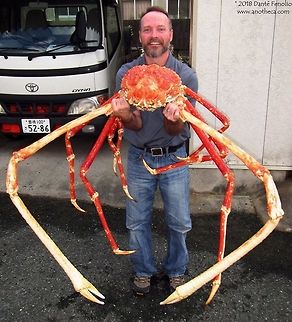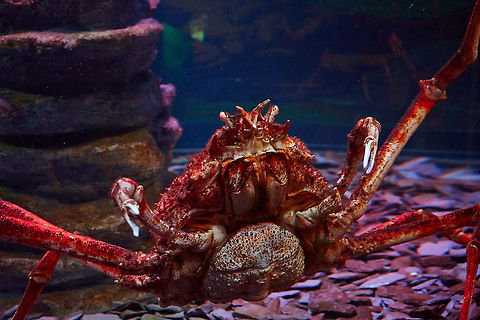
Appearance
The Japanese spider crab has the greatest wing span of any arthropod, reaching 3.8 metres from claw to claw. The body may grow to a size of 40 cm or 16 in and the whole crab can weigh up to 19 kilograms . The males have the longer chelipeds; females have much shorter chelipeds, which are shorter than the following pair of legs. Apart from its outstanding size, the Japanese spider crab differs from other crabs in a number of ways. The first pleopods of males are unusually twisted, and its larvae appear primitive. The crab is orange, with white spots along the legs. It is reported to have a gentle disposition, despite its ferocious appearance.
Distribution
Japanese spider crabs are mostly found off the southern coasts of the Japanese island of Honshū, from Tokyo Bay to Kagoshima Prefecture. Outlying populations have been found in Iwate Prefecture and off Su-ao in Taiwan. Adults can be found at depths of up to 600 m , or as shallow as 50 m . They like to inhabit vents and holes in the deeper parts of the ocean.Behavior
Female crabs carry the fertilized eggs attached to her abdominal appendages until they hatch into tiny planktonic larvae. Development of the planktonic larvae is temperature-dependent and takes between 54 and 72 days at 12–15 °C . During the larval stage the young crab looks nothing like its parents. It is small and transparent with a round, legless body and usually drifts as plankton at the surface of the ocean. The Japanese spider crab is an omnivore, consuming both plant matter and animals. It also sometimes acts as a scavenger consuming dead animals. Some have been known to scrape the ocean floor for plants and algae while others pry open the shells of mollusks. They live at depths of 150–300 metres or more. The giant spider crabs migrate up to a depth of around 50 metres during breeding season.Evolution
The Japanese spider crab was originally described by western science in 1836 by Coenraad Jacob Temminck under the name ''Maja kaempferi'', based on material from Philipp Franz von Siebold collected near the artificial island Dejima. The specific epithet commemorates Engelbert Kaempfer, a German naturalist who lived in Japan from 1690 to 1692 and wrote about the country's natural history. It was moved to the genus ''Inachus'' by Wilhem de Haan in 1839, but placed in a new subgenus, ''Macrocheira''. That subgenus was raised to the rank of genus in 1886 by Edward J. Miers. Although currently placed in the family Inachidae, ''M. kaempferi'' does not fit cleanly into that group, and it may be necessary to erect a new family just for the genus ''Macrocheira''. As well as the single extant species, four species belonging to the genus ''Macrocheira'' are known from fossils.References:
Some text fragments are auto parsed from Wikipedia.